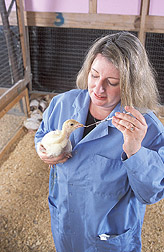|
|
|
 |
| 
ARS scientists Tommy Wheeler and Steven
Shackelford sample microorganisms from a cow's hide as part of developing
technology to make beef safer. Click the image for more information about
it.
|

|

ARS and University of Arkansas, Fayetteville,
researchers have developed a way to identify beneficial bacteria that can be
fed to poultry to reduce the risk of contamination by bacteria that causes
human food borne illness. Click the image for more information about
it.
|
ARS Honors Technology Transfer Award Winners
By Laura
McGinnis
February 13, 2008 WASHINGTON, February 13,
2008—Food safety researchers top the list of teams who are receiving
2007 Technology Transfer Awards from the Agricultural Research Service (ARS),
the U.S. Department of Agriculture's chief
intramural scientific research agency. These awards recognize ARS researchers
who successfully develop and deliver new technology for public use.
For developing technology to reduce pathogen contamination of beef and
poultry, ARS research teams at Clay Center, Neb., and Fayetteville, Ark.,
received 2007 Technology Transfer Awards for Outstanding Efforts. They were
recognized this week with six other teams at the ARS Annual Recognition
Program.
"The research honored this year exemplifies our agency's commitment to
developing agricultural solutions and making them available to researchers,
scientists and members of the general public," said ARS Administrator
Edward
B. Knipling.
Scientists at the Roman L. Hruska U.S. Meat Animal Research Center (USMARC) in Clay
Center were recognized for developing a chemical hide-washing system that
removes E. coli O157:H7 and other dangerous microorganisms from cattle
hides before processing. The treatment is used on an estimated 40 percent of
U.S. feedlot-raised beef cattle, and saves the U.S. beef industry millions of
dollars every year. Since the industry adopted the technology, the amount of
ground beef in the United States testing positive for E. coli O157:H7
has dropped by about 43 percent. The research was led by USMARC Director
Mohammad
Koohmaraie. (Team members)
Research conducted at the
Poultry
Production and Product Safety Research Unit in Fayetteville also helped
reduce the risk of foodborne pathogen contamination. Research leader
Ann M.
Donoghue, with colleagues at the University of Arkansas, developed a new
method for identifying beneficial probiotic bacteria. When consumed by poultry,
such bacteria crowd out pathogenic bacteria such as Salmonella and
Campylobacter inside the bird, improving bird health and food safety.
Billions of chickens and turkeys throughout the world stand to benefit from the
adoption of this research. (Team members)
ARS also recognized six individuals and groups for Superior Efforts in
Technology Transfer:
- Carlos B.
Armijo, a textile technologist at the Southwestern Cotton Ginning Research
Laboratory in Mesilla Park, N.M., developed a high-speed roller gin stand that
increases the ginning speed of upland cotton by about 500 percent. These stands
are being used by commercial and private ginning operations.
- Rodney G.
Roberts, a plant pathologist at the
Tree
Fruit Research Laboratory in Wenatchee, Wash., developed fire blight
detection assays and a treatment protocol demonstrating that U.S. apples were
not infected with fire blight and, therefore, unlikely to carry the disease
abroad. This research led several foreign countries, including Japan, to allow
imports of U.S. apples, opening up a multimillion-dollar market.
- Led by research leader
John
B. Luchansky, the
Microbial
Food Safety Research Unit's Special Projects Team at the Eastern Regional
Research Center (ERRC)
in Wyndmoor, Pa., developed a process to enhance the safety of ready-to-eat
meat and poultry products. The Sprayed Lethality in Container, or SLIC,
intervention method reduces the prevalence of Listeria monocytogenes by
99.999 percent within 24 hours. Several food processors in the United States
and England have adopted the SLIC technology. (Team
members)
- A new, low-glycemic-index sweetener is the byproduct of ARS research into
value-added carbohydrates. Under the leadership of
Gregory
L. Cote, scientists at the
National
Center for Agricultural Utilization Research in Peoria, Ill., have been
converting agricultural materials into prebiotics. Working with industry
scientists, the team applied the technology to sugar and corn syrup, resulting
in the creation of Xtend™ sucromalt. (Team
members)
-
Charles Onwulata, a food technologist in the ERRC
Dairy
Processing and Products Research Unit in Wyndmoor, has developed a method
for enriching snacks and cereals with byproducts derived from the cheese-making
process. The byproducts improve the nutritional value of snacks by raising
their protein content without affecting taste, texture or appearance.
[Top]
|
|
|
|